Adventure Time: The Rise of Old School Adventure Games on Nintendo Consoles
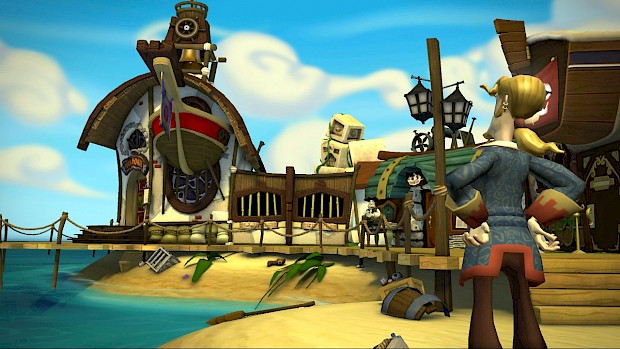
Posted 18 Dec 2012 at 12:10 by The Bard
When Nintendo first unveiled their strategies for the original DS and subsequently the Wii, their audience were embroiled, en masse, in speculation about what these new and off-the-wall control types and console designs would mean for the future of software on Nintendo’s machines. The assumptions were many, and among them were ideas that developers would be afforded a new lease of creativity, inevitably in hopes of creating new genres that would be as wildly imaginative as the consoles they would appear on, and re-invigorating existing ones with a sense of the intuitive that was perhaps lost with the ten button controllers that had become standardised. Whatever can be said for the fate of these expectations, something came about that perhaps not so many foresaw; the revitalization of a genre that had not only been dormant, but had long been considered the irrelevant reserve of the PC hardcore. Of course, the old school Adventure game.
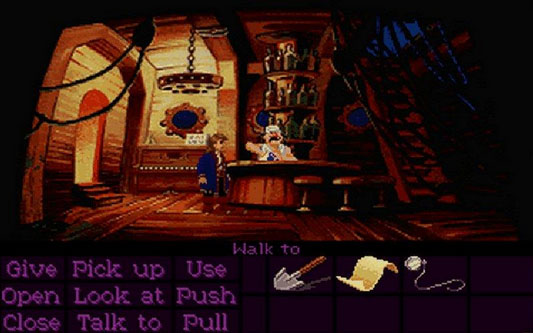
PC Adventure games are informed by design that involves close observation of environmental clues, and a sort of bizarre, often kooky, largely inductive way of reasoning that requires the player to combine items in very specific ways, and use them as varieties of “keys” that induce a reaction in the game world, and drive progress. When done right – a very occasional event, with elusive requisites – a good adventure can enthral, engross and entertain even while it perplexes and causes you to think carefully through possible solutions.
Roberta Williams, creator of the King’s Quest series of adventure games once said, “I think in the last 5 or 6 years, the demographics have really changed; now this is my opinion, because computers are less expensive so more people can afford them. More "average" people now feel they should own one.”
The comment reads like a sort of dry admonishment, and was in response to the fact that adventure game sales were taking a downward turn, and formed a lesser proportion of sales as a whole than previously. It was a sort of a knee-jerk, defensive proclamation insinuating that adventure games weren’t proliferating because people of - how should one say – dubious mental capacity, were buying computers. The counterpoint, of course was the fact that adventure games seemed to be taking on a sense of internal logic that became progressively more insane, often devolving into pixel hunts for the sole interactive spot in a frame, or item combinations that made no sense. This school of game design culminated in the infamous and often ridiculed cat-hair moustache puzzle from Gabriel Knight 4 – an example of how completely out of touch creators had become with player need for clear, intuitive design. The idea was that these games that ostensibly required a level of canny observation were instead becoming completely bereft of any unifying logic and clarity in the game world. If Williams’ point was salient in its implications, then growing popularity of consoles made entirely for gaming should have had a further adverse effect on the genre she helped start. Rather than prove her point though, the birth of the DS and Wii, helped spark life into the old ghost, and streamlined the genre for a new generation.
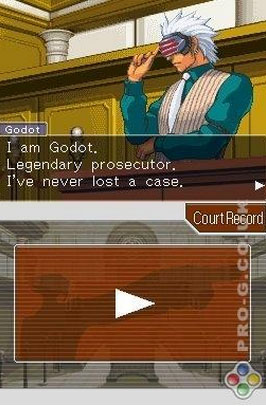 The DS came first, and with it, a legion of games in this style, ranging from Phoenix Wright to Lost in Blue, to Hotel Dusk; each game pushing its own idiosyncrasy, and its own unique wrinkle on the template. The original Phoenix Wright came out on the Gameboy Advance in 2001, before being ported to the DS in 2005, where it found an audience and expanded into a series. The games see you play as rookie attorney Phoenix, as he makes his way in the profession and through some unbelievably bizarre, incredibly entertaining and downright Japanese scenarios. On some level it can be seen as a commentary on odd nature of the Japanese penal system, and on another as an exercise in adjusting the adventure game model for a handheld audience. The game’s template is based on a dichotomy in scenarios. First is forensic examination which takes place in various locales and crime scenes around the game world, where Phoenix and his companions interview possible witnesses and scan the environment for hidden clues. The second part of each case is triggered when all possible evidence has been collected, and the scene shifts to the courtroom where Phoenix is tasked with presenting his case. It’s interesting for this, because it very clearly telegraphs what is expected of the player in any given scenario; in forensic situations, you’re tasked with collecting incriminating or acquitting evidence in the form of items or other clues, and in the court room, with augmenting your argument by presenting these at the correct times. Still, the cues in the courtroom can at times be opaque and elusory, and occasionally this is part of the fun. At other times, when you’ve presented every item in your inventory, it devolves into something uncannily like the frustration experienced in traditional entries in the genre. Nevertheless, the games have accrued a rather large cult audience, and evolved a method of making the genre more accessible to an audience of newcomers.
The DS came first, and with it, a legion of games in this style, ranging from Phoenix Wright to Lost in Blue, to Hotel Dusk; each game pushing its own idiosyncrasy, and its own unique wrinkle on the template. The original Phoenix Wright came out on the Gameboy Advance in 2001, before being ported to the DS in 2005, where it found an audience and expanded into a series. The games see you play as rookie attorney Phoenix, as he makes his way in the profession and through some unbelievably bizarre, incredibly entertaining and downright Japanese scenarios. On some level it can be seen as a commentary on odd nature of the Japanese penal system, and on another as an exercise in adjusting the adventure game model for a handheld audience. The game’s template is based on a dichotomy in scenarios. First is forensic examination which takes place in various locales and crime scenes around the game world, where Phoenix and his companions interview possible witnesses and scan the environment for hidden clues. The second part of each case is triggered when all possible evidence has been collected, and the scene shifts to the courtroom where Phoenix is tasked with presenting his case. It’s interesting for this, because it very clearly telegraphs what is expected of the player in any given scenario; in forensic situations, you’re tasked with collecting incriminating or acquitting evidence in the form of items or other clues, and in the court room, with augmenting your argument by presenting these at the correct times. Still, the cues in the courtroom can at times be opaque and elusory, and occasionally this is part of the fun. At other times, when you’ve presented every item in your inventory, it devolves into something uncannily like the frustration experienced in traditional entries in the genre. Nevertheless, the games have accrued a rather large cult audience, and evolved a method of making the genre more accessible to an audience of newcomers.
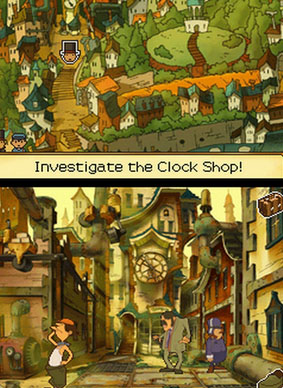 The Professor Layton games, came sometime later, with Curious Village arriving in 2007, and unlike Phoenix Wright, had a uniquely European aesthetic to it, with houses and masonry that had a rural French feel, which the accordion backed soundtrack only deepened. It has perhaps a more professional presentation than the Phoenix games, with cut scenes in beautiful hand animated style, and pretty great voice over work. Undeniably distinguished gentleman Layton, who for some nebulous reason travels everywhere with a young schoolboy named Luke, has some sort of idiot-savant esque obsession with puzzle solving in unlikely, occasionally inappropriate situations. These are hidden everywhere in the world. Bushes, buildings, random items, and dialogue with any given character reveal yet another quaint puzzle to solve. In Professor Layton, the correlation between environment and puzzle is pretty loose, and the world is there not so much to provide a consonance between interaction and narrative, but to give the game a veneer of lightness and atmosphere. In this sense it succeeds to a large degree, and also avoids the pitfalls of the graphic adventure genre where the parameters and the rules are often plagued by vagueness and random luck. In the Layton games, there’s a pristine clarity to puzzle logic, simply because the logic derives from the real world; solving a knight’s tour on a chess board, or filling different volumetric flasks with identical amounts of liquid aren’t tasks that are mired in the abstractions of a game world and its internal logic - their rules are laid out plainly before you. Puzzles are never frustrating to the point of being unsolvable, and for younger audiences there’s a tiered hint system for every puzzle that nudges you towards the correct solution. All of this helps circumvent the limitations and frustrations of the genre that constricted its proliferation into the hands of a wider audience.
The Professor Layton games, came sometime later, with Curious Village arriving in 2007, and unlike Phoenix Wright, had a uniquely European aesthetic to it, with houses and masonry that had a rural French feel, which the accordion backed soundtrack only deepened. It has perhaps a more professional presentation than the Phoenix games, with cut scenes in beautiful hand animated style, and pretty great voice over work. Undeniably distinguished gentleman Layton, who for some nebulous reason travels everywhere with a young schoolboy named Luke, has some sort of idiot-savant esque obsession with puzzle solving in unlikely, occasionally inappropriate situations. These are hidden everywhere in the world. Bushes, buildings, random items, and dialogue with any given character reveal yet another quaint puzzle to solve. In Professor Layton, the correlation between environment and puzzle is pretty loose, and the world is there not so much to provide a consonance between interaction and narrative, but to give the game a veneer of lightness and atmosphere. In this sense it succeeds to a large degree, and also avoids the pitfalls of the graphic adventure genre where the parameters and the rules are often plagued by vagueness and random luck. In the Layton games, there’s a pristine clarity to puzzle logic, simply because the logic derives from the real world; solving a knight’s tour on a chess board, or filling different volumetric flasks with identical amounts of liquid aren’t tasks that are mired in the abstractions of a game world and its internal logic - their rules are laid out plainly before you. Puzzles are never frustrating to the point of being unsolvable, and for younger audiences there’s a tiered hint system for every puzzle that nudges you towards the correct solution. All of this helps circumvent the limitations and frustrations of the genre that constricted its proliferation into the hands of a wider audience.
There are other notable adventure experiences on the DS, such as Hotel Dusk, but many of these tend to conform to the traditional template with all of its old frustrations. These days, the integration of game systems and mechanics in video games are following an almost mirror path to the evolution of videogame storytelling: Whereas in times past, story exposition has occurred through extensive cut scenes and dialogue that required a stop in the interaction, we are now moving towards storytelling methods that are implicit in the way the world of a game is organised, and the same goes for puzzles. Where we would previously be required to stop, say, in a Resident Evil and solve a literal slide puzzle to open a pathway, now in games such as Half Life, the puzzle elements are actually part of the physics as they are integrated into the environment, allowing for a more fluid sense of pacing and cohesion within the game world.
Nintendo have always been a company apart, fastidious in their design vision and very much prone to ignoring industry trends, but in a sense, they were pioneers of environmental storytelling and puzzle integration. The Metroid series, for example, all the way from the original to the Prime series, rarely relied on text or video as context for story, but rather, hinged on visual cues, and rewarded your sleuthing and curiosity. Exploration of Zebes revealed a civilisation eradicated by predators, eroded and overgrown with foliage and overrun by creatures that seem evolved to take advantage of the narrow crawl spaces and overhanging canopies. Upon landing on Tallon IV in the original Prime, you gathered a sense of ecology with an aesthetic consistency as you travelled from zone to zone, traversing obstacles, with Samus’ suit and abilities constructed specifically to take advantage of the particulars of Chozo architecture and engineering. Sure, the idea of every mechanism from Zebes to Aether being powered and manipulated via morph ball seems a little contrived, but it’s a small suspension of disbelief for the gain in such a tight feel and vibe. The Zelda series functions much the same way, albeit with a more fairytale-esque wrinkle on the trappings.
A little of Nintendo’s design sense seems to have trickled into third party games created for its systems, and these sensibilities served as a panacea for a genre that had lagged in obscurity for so many years. Between games like Metroid and The Secret of Monkey Island, there had been abstract similarities in the sense that puzzles consisted of collecting items or abilities that interacted with the environment in novel ways. There was an emphasis on visual memory and observation. The dissimilarities between console and PC Adventure games were in the particulars of style and interface, and this is something that was resolved with the release of the DS and Wii systems, both of which allowed, to varying degrees, input that was able to emulate the precision and speed of a mouse.
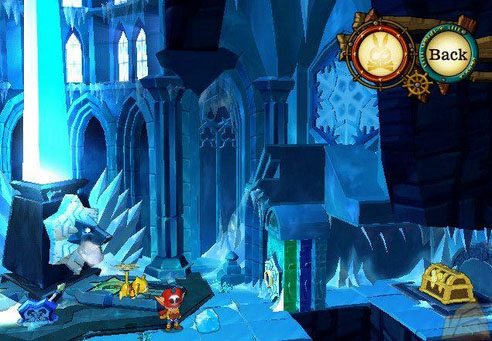
The Wii was essentially the first home console that seemed like the viable candidate for adventure gaming. One of the most notable of these, Zack and Wiki: Quest for Barbaros’ Treasure, despite having a name just as ridiculous and imaginative as its presentation and graphical style, is perhaps one of the most unique and interesting titles to appear on a Nintendo console for years. The set up is that you play as Zack, kooky midget and pirate extraordinaire, and his flying monkey companion Wiki, who has the ability to transform into a bell that in turn transforms animate objects such as snakes, centipedes and such, into items that can be used to solve puzzle elements around the game world. They crash on an island and happen upon a gaudy golden skull that demands you re-assemble the remaining parts of its skeleton. Essentially, the story can be jettisoned when considering the game, because it’s only there to give a thin overarching motive to go from level to level. That, really, is the interesting thing about Zack and Wiki: In structure, it consists of little vignettes – small, self contained levels that have their own neat solution, and exist entirely for the puzzle – rather than the traditional adventure game trait of having an environment that functions as a narrative space, with puzzles peppered throughout. This provides the benefit of a sense of clarity to the proceedings; you know that each level can be solved with the tools made available within them, and furthermore, each item you find has fixed utility – centipedes saw, umbrellas can be used to prod, protect or grab depending on which end you use etc.
In this way, Zack and Wiki contains a logic that’s incorporated directly into the visual space, and vertically integrated into its mechanics. Everything that can be used around the level is immediately apparent, and in itself provides clues that nudge you toward the solution – oh, there’s a centipede saw? I suppose it must be used to saw down the stick propping up this rock. The amazingly intuitive visual design of the game leaves it free to incorporate more complexity into level design and scenarios that later on in the game become fiendishly puzzling and for that reason, so completely satisfying to solve. The functions of the Wii controller are integrated into the entirety of the game in an interesting way providing a unique way to interface with practically every interactive object. Keys have to be turned, and bells have to be jingled with actual physical motion, which doesn’t really add much to the game, but was a novel way to interact when the game released. Everything about the game had a completely novel, unique feel to it, and in retrospect, trapped in the amber, it seems like there probably won’t be a game quite like it ever again.
Beyond Zack and Wiki, and some of Telltale games’ adventure series such as Sam & Max, it’s a shame that the Wii didn’t see that much more in the same vein. There’s an optimistic future though. With the recent release of the Wii U, Nintendo has created a console that offers something like the DS’ touch screen interface, as well as incorporating a more precise version of Wii Remote controls. From now, it just remains to be seen if developers will leverage these features to take advantage of the fact that the Wii U seems like a more than ideal place to rally the cause, and continue innovation on the adventure game front.





















